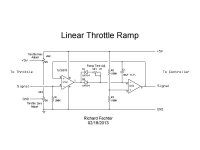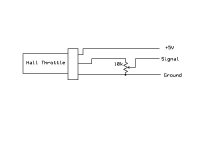Here's something I've been brewing for a long time. This is still in the development stage. In other words, I have not actually built one yet so there could be some tweaking necessary.
The crudest version of the 'throttle smoother' is simply a pot in series with the ground wire of the throttle that allows you to adjust the zero point of the throttle. This typically gives a better response at the low end and reduces the tendency to have a surge of power on takeoff.
This circuit has that feature, as well as corresponding high side pot to adjust the maximum throttle. This will allow the throttle to work throughout it's entire range of motion. These adjustment pots can be left off if only the ramp control is desired.
The main feature is a true linear ramp circuit that is adjustable for ramp speed. If the throttle is suddenly increased, the output ramps up linearly at a fixed rate until the output matches the throttle setting. If the throttle is suddenly decreased, the output decreases at the rate of the input. The ramp speed adjustment can be varied from near zero to about 5 seconds for full swing. The value of VR1 and C1 determine the ramp rate.
Most ramp circuits delay the decrease in throttle at the same rate as the increase. This is bad when you want to do a panic stop. The diodes provide a separate rate in each direction. If you wanted some delay in the decrease, adding a resistor in series with D2 would allow this.
The circuit will output a signal that matches the input. This should work over the entire 0-5v range if the specified op amp is used. Most hall effect throttles don't go all the way to the rails, so pretty much any op amp should work for this. For controllers that need a full 0-5v range, a rail-to-rail op amp is needed. For a typical hall effect setup, a cheap op amp like a TL082 should work fine.
Timing capacitor C1 need to be non polar. A MLCC or non polar electrolytic should be used. You can place two regular electrolytics back to back to make a non polar if the part is hard to find. Just remember the capacitance of two series caps is half the value of the individual ones.

Soooo... what's so great about this? By using a linear ramp, the current draw of the motor during acceleration will be nearly constant. This reduces current peaks that cause component strain and wasted power. Motor and controller heating will be reduced as well. If the ramp speed is too fast, it will behave like it did without the circuit. If the ramp speed is too slow, it could be annoying. It should be possible to set the ramp speed such that the overall acceleration is not reduced significantly, but you still shave some excess watts during takeoff. For maximizing range, a slower ramp time is better.
For very high powered setups, like Luke's DeathBike, a slower ramp will help keep the front wheel on the ground, even when ridden by an idiot.
The crudest version of the 'throttle smoother' is simply a pot in series with the ground wire of the throttle that allows you to adjust the zero point of the throttle. This typically gives a better response at the low end and reduces the tendency to have a surge of power on takeoff.
This circuit has that feature, as well as corresponding high side pot to adjust the maximum throttle. This will allow the throttle to work throughout it's entire range of motion. These adjustment pots can be left off if only the ramp control is desired.
The main feature is a true linear ramp circuit that is adjustable for ramp speed. If the throttle is suddenly increased, the output ramps up linearly at a fixed rate until the output matches the throttle setting. If the throttle is suddenly decreased, the output decreases at the rate of the input. The ramp speed adjustment can be varied from near zero to about 5 seconds for full swing. The value of VR1 and C1 determine the ramp rate.
Most ramp circuits delay the decrease in throttle at the same rate as the increase. This is bad when you want to do a panic stop. The diodes provide a separate rate in each direction. If you wanted some delay in the decrease, adding a resistor in series with D2 would allow this.
The circuit will output a signal that matches the input. This should work over the entire 0-5v range if the specified op amp is used. Most hall effect throttles don't go all the way to the rails, so pretty much any op amp should work for this. For controllers that need a full 0-5v range, a rail-to-rail op amp is needed. For a typical hall effect setup, a cheap op amp like a TL082 should work fine.
Timing capacitor C1 need to be non polar. A MLCC or non polar electrolytic should be used. You can place two regular electrolytics back to back to make a non polar if the part is hard to find. Just remember the capacitance of two series caps is half the value of the individual ones.

Soooo... what's so great about this? By using a linear ramp, the current draw of the motor during acceleration will be nearly constant. This reduces current peaks that cause component strain and wasted power. Motor and controller heating will be reduced as well. If the ramp speed is too fast, it will behave like it did without the circuit. If the ramp speed is too slow, it could be annoying. It should be possible to set the ramp speed such that the overall acceleration is not reduced significantly, but you still shave some excess watts during takeoff. For maximizing range, a slower ramp time is better.
For very high powered setups, like Luke's DeathBike, a slower ramp will help keep the front wheel on the ground, even when ridden by an idiot.


